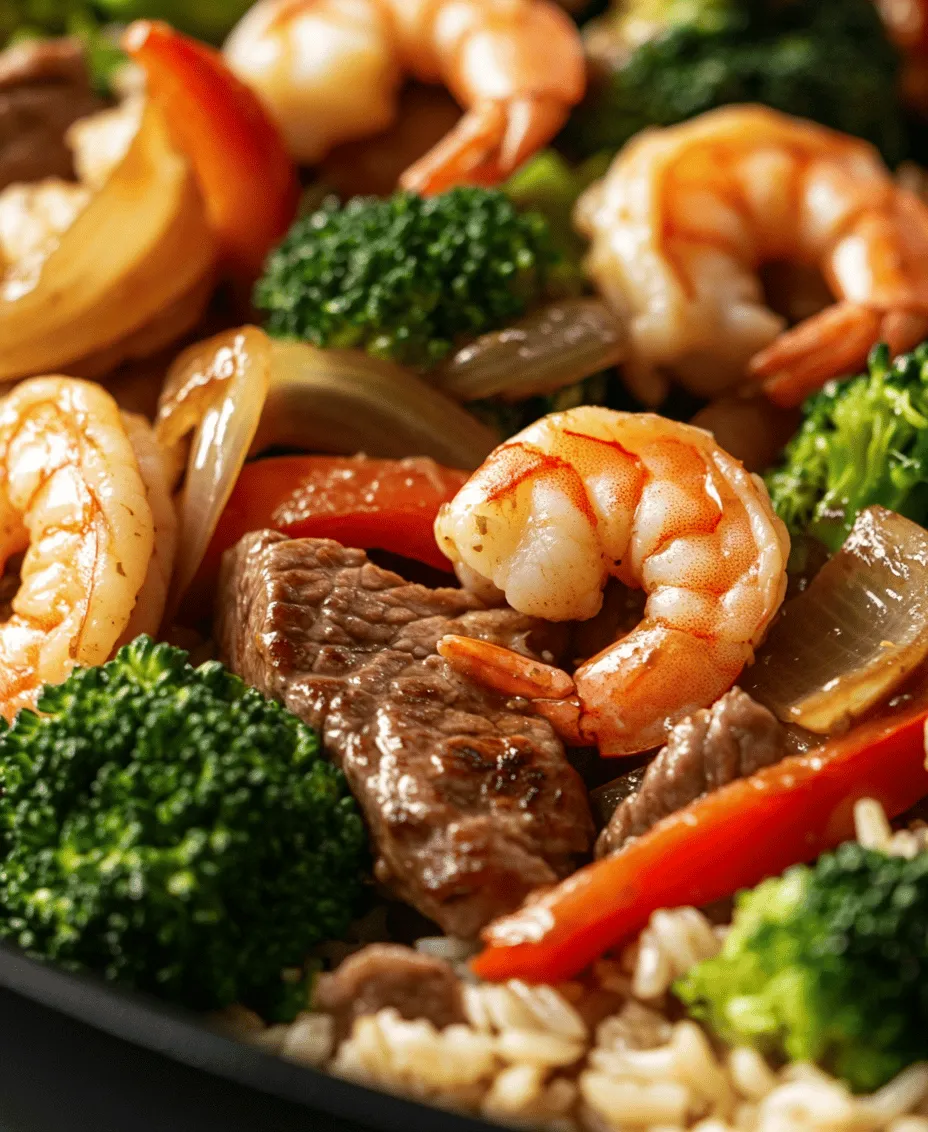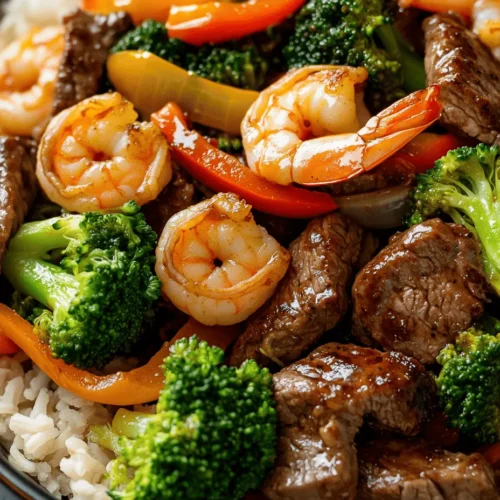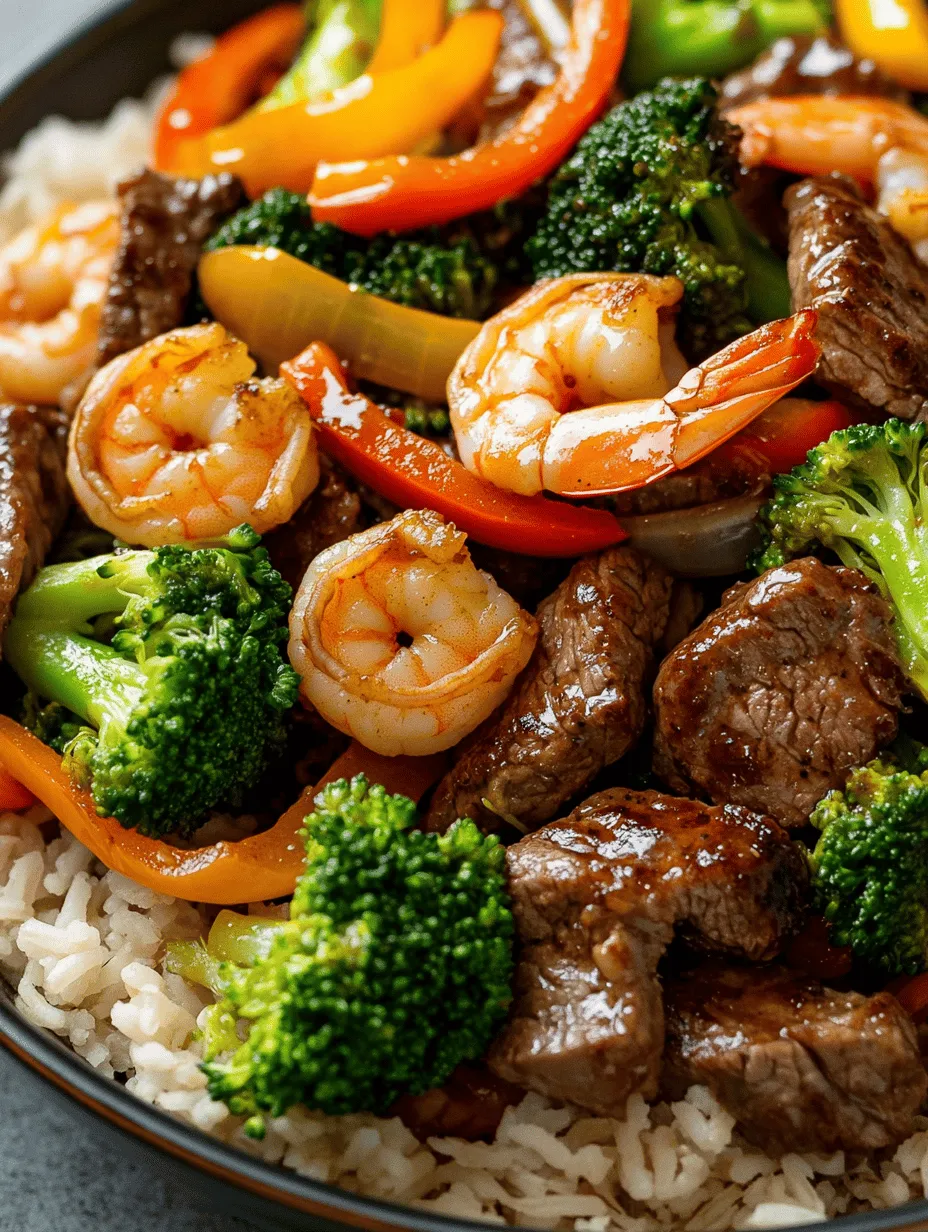Introduction
Stir-frying is more than just a cooking technique; it’s a culinary art that has roots in Asian cuisine. This method involves quickly cooking ingredients in a hot pan with a small amount of oil, resulting in vibrant dishes that retain the flavors and nutrients of the food. The fast-paced nature of stir-frying not only preserves the texture of the ingredients but also allows for a multitude of flavor combinations, making it a favorite among home cooks and professional chefs alike.
In today’s health-conscious world, the demand for high-protein meals has surged. Protein is an essential nutrient that plays a critical role in building and repairing tissues, producing enzymes and hormones, and supporting overall health. High-protein dishes can help maintain muscle mass, promote satiety, and aid in weight management. The recipe we’re diving into today, High-Protein Steak and Shrimp Stir-Fry, is a perfect representation of this trend. Combining tender sirloin steak and succulent shrimp with a colorful array of vegetables, this dish is not only flavorful but also packed with nutritional benefits. It’s a quick and easy option for busy weeknights, delivering a satisfying meal that won’t compromise your health goals.
Understanding the Ingredients
Sirloin Steak
Sirloin steak is a prime cut of beef known for its balance of flavor and tenderness. This cut comes from the rear back portion of the cow and is often favored for stir-frying due to its relatively low fat content and robust taste. Nutritionally, sirloin steak is an excellent source of high-quality protein, iron, zinc, and B vitamins, which are essential for energy metabolism and overall health.
When selecting sirloin steak for stir-fry, look for cuts that are bright red in color with a good amount of marbling, which contributes to the flavor and juiciness of the meat. Ideal cuts for stir-frying include top sirloin or sirloin tip, as they are tender and can be cooked quickly without becoming tough. To enhance tenderness, it’s crucial to slice the steak against the grain into thin strips before cooking. This technique shortens the muscle fibers, making each bite more tender and easier to chew.
Shrimp
Shrimp is another protein powerhouse, packed with essential nutrients and low in calories. It’s a great source of omega-3 fatty acids, which support heart health, and is rich in selenium, vitamin B12, and iodine. These nutrients not only contribute to overall health but also play a role in metabolic processes and maintaining a healthy immune system.
When it comes to sourcing shrimp for your stir-fry, you have the option of fresh or frozen. Fresh shrimp can be a delightful treat if you have access to a reliable seafood market, but frozen shrimp are often just as good, as they are typically frozen shortly after being caught, preserving their freshness. If using frozen shrimp, be sure to thaw them properly before cooking. Rinse them under cold water and pat them dry to ensure they sear nicely in the pan.
Vegetables
A key component of any stir-fry is the vibrant mix of vegetables that not only enhance the dish’s appearance but also contribute to its nutritional value. In this recipe, we’ll focus on three primary vegetables: broccoli, bell pepper, and onion.
– Broccoli is a cruciferous vegetable packed with vitamins C and K, fiber, and a host of antioxidants. Its crunchy texture adds a delightful contrast to the tender meat and shrimp, making each bite satisfying.
– Bell peppers come in various colors—red, yellow, and green—and are rich in vitamins A and C. They add sweetness and a pop of color to the dish, making it visually appealing.
– Onions provide a savory depth of flavor and contain beneficial compounds that may support heart health. They caramelize beautifully when stir-fried, enhancing the overall taste of the dish.
Garlic
Garlic is a staple in many cuisines, celebrated not only for its flavor but also for its numerous health benefits. It contains compounds like allicin, which have been linked to improved heart health, boosted immune function, and anti-inflammatory properties. In our stir-fry, garlic plays a dual role: it infuses the dish with its distinctive aroma and enhances the flavors of the other ingredients.
Sauces
Sauces are the backbone of any stir-fry, providing depth and complexity to the dish. In this recipe, we will use soy sauce and oyster sauce, both of which add umami flavor and richness.
– Soy sauce is a fermented product made from soybeans and wheat and is a staple in many Asian dishes. It comes in various types, including light, dark, and low-sodium options, allowing for flexibility based on dietary preferences.
– Oyster sauce is made from oyster extracts and is known for its sweet and savory flavor profile. It can also enhance the natural flavors of the ingredients in the stir-fry. If you have dietary restrictions, consider using mushroom sauce as a vegetarian alternative, which mimics the umami taste without the seafood.
Preparation and Cooking Techniques
Importance of Ingredient Preparation
Preparation is key to a successful stir-fry. Before you begin cooking, it’s essential to have all your ingredients prepped and ready to go. This not only streamlines the cooking process but also ensures that everything cooks evenly and efficiently. Stir-frying is a quick cooking method, and having the ingredients chopped, sliced, and measured can help prevent overcooking or burning.
How to Slice Steak Properly
To achieve tender pieces of steak in your stir-fry, slicing is crucial. Start by placing the sirloin steak in the freezer for about 15-20 minutes. This will firm up the meat, making it easier to slice. Once firm, remove it from the freezer and use a sharp knife to cut against the grain into thin strips, about 1/4 inch thick. The grain refers to the direction of the muscle fibers, and cutting against it shortens these fibers, resulting in a more tender bite.
Properly Preparing Shrimp for Stir-Frying
If you’re using raw shrimp, it’s important to clean and devein them before cooking. Start by removing the shells and tails, then use a small knife to make a shallow cut along the back to expose the dark vein. Rinse the shrimp under cold water and pat them dry with paper towels. This step is crucial for achieving a good sear during cooking, as excess moisture can lead to steaming rather than frying.
Chopping Vegetables for Optimal Cooking and Presentation
When it comes to vegetables, uniformity in size is essential for even cooking. Chop the broccoli into bite-sized florets, slice the bell pepper into thin strips, and dice the onion into small pieces. This ensures that all vegetables cook at the same rate and maintain their crunchiness. Additionally, cutting vegetables into visually appealing shapes can enhance the presentation of your dish, making it more appetizing.
Step-by-Step Cooking Process
The actual cooking process for a stir-fry is quick, making it imperative to be prepared. Here’s a simple breakdown of the cooking process:
1. Heat the Wok or Pan: Begin by heating a wok or a large skillet over high heat. A well-seasoned cast-iron wok is ideal, but a non-stick skillet can work too. The key is to ensure it’s hot enough to achieve a perfect sear.
2. Add Oil: Once the pan is hot, add a high smoke point oil like canola, grapeseed, or peanut oil. Swirl the oil around to coat the surface evenly.
3. Cook the Steak: Add the sliced sirloin steak to the pan in a single layer. Allow it to sear without stirring for about 1-2 minutes, then stir-fry until browned and cooked to your desired doneness. Remove the steak from the pan and set it aside.
4. Stir-Fry the Shrimp: In the same pan, add a little more oil if needed and toss in the cleaned shrimp. Cook for 2-3 minutes until they turn pink and opaque. Remove and set aside with the steak.
5. Sauté the Vegetables: Add the chopped onions and bell peppers to the pan, followed by the broccoli florets. Stir-fry for about 3-4 minutes until the vegetables are tender-crisp.
6. Combine and Season: Return the cooked steak and shrimp to the pan. Add minced garlic, soy sauce, oyster sauce, and any additional seasoning you prefer. Toss everything together and cook for another minute to allow the flavors to meld.
Heating Techniques to Achieve the Perfect Sear on Steak
Achieving the perfect sear on your steak is all about temperature control. The pan must be hot enough to create a Maillard reaction, which gives the meat its rich flavor and appealing crust. Make sure not to overcrowd the pan, as this can lower the temperature and prevent proper browning. If you’re cooking a larger batch, consider cooking the steak in two or more batches to ensure each piece is perfectly seared.
The Role of Oil in Stir-Frying: Choosing the Right Type
Choosing the right oil for stir-frying is crucial for both flavor and health. Oils with a high smoke point, such as canola, grapeseed, or peanut oil, are ideal as they can withstand the high temperatures required for stir-frying without burning. Avoid using oils with low smoke points, like olive oil, as they can produce off-flavors and harmful compounds when heated too high.
In conclusion, the High-Protein Steak and Shrimp Stir-Fry is not just a meal; it’s a celebration of flavors and nutrition. With the right ingredients and techniques, you can create a dish that’s not only satisfying but also aligns with your health goals. Follow the preparation and cooking steps outlined here, and you’ll be well on your way to mastering this delicious stir-fry!

Tips for Achieving the Ideal Vegetable Texture: Tender-Crisp vs. Fully Cooked
When preparing your High-Protein Steak and Shrimp Stir-Fry, achieving the perfect vegetable texture is crucial for both flavor and presentation. The key lies in understanding the difference between tender-crisp and fully cooked vegetables.
Tender-Crisp Vegetables:
For a tender-crisp texture, cook your vegetables until they are vibrant and slightly tender but still retain some crunch. This technique ensures that the vegetables not only add color but also maintain their nutritional value. To achieve this, follow these tips:
– Blanching: Lightly blanch your vegetables in boiling water for a minute before adding them to the stir-fry. This helps to preserve their bright color and nutrient content.
– High Heat: Use a high flame to quickly sear the vegetables, allowing them to cook evenly without becoming overly soft.
– Timing: Add quick-cooking vegetables like bell peppers, snap peas, or broccoli last to the stir-fry. This way, they absorb the flavors of the dish without losing their texture.
Fully Cooked Vegetables:
If you prefer fully cooked vegetables, simply extend the cooking time. This allows the flavors to meld together and results in a softer texture. Here are some additional tips for fully cooked vegetables:
– Slice Uniformly: Cut your vegetables into uniform pieces to ensure they cook at the same rate.
– Steaming: Consider steaming your vegetables before adding them to the pan; this method softens them without losing much flavor.
– Add Oil Wisely: Adjust the amount of oil used in the stir-fry; a bit more oil can help to achieve a more tender finish.
By mastering these techniques, you can customize your stir-fry to suit your personal taste while ensuring that each ingredient shines.
Nutritional Breakdown of the Dish
Understanding the nutritional value of your High-Protein Steak and Shrimp Stir-Fry can enhance your cooking experience. Here’s a detailed analysis of its macronutrient content:
Protein Content from Steak and Shrimp:
Both steak and shrimp are excellent sources of high-quality protein. A typical serving of this stir-fry can provide:
– Steak: A 3-ounce serving of lean beef steak contains approximately 22 grams of protein.
– Shrimp: A 3-ounce serving of shrimp packs about 20 grams of protein.
Combining these two protein sources not only boosts the overall protein content to around 42 grams per serving but also creates a diverse amino acid profile that supports muscle building and repair.
Fiber and Vitamins from Vegetables:
The vegetables in your stir-fry contribute essential vitamins and minerals, as well as dietary fiber. For instance:
– Broccoli: High in vitamin C, vitamin K, and dietary fiber, contributing to digestive health.
– Bell Peppers: Excellent sources of vitamins A and C, enhancing immune function.
– Carrots: Rich in beta-carotene, which is converted to vitamin A in the body.
Incorporating a variety of colorful vegetables not only enhances the dish’s flavor but also increases its nutritional profile.
Healthy Fats from Olive Oil:
Olive oil is a heart-healthy fat that adds flavor to your stir-fry. A tablespoon of olive oil contains about 14 grams of fat, primarily monounsaturated fats, which are beneficial for heart health. This type of fat can help to lower bad cholesterol levels and reduce the risk of heart disease.
Pairing with Brown Rice or Quinoa:
For a complete meal, consider serving your stir-fry alongside brown rice or quinoa. Both grains offer unique nutritional benefits:
– Brown Rice: A great source of complex carbohydrates and fiber, brown rice provides sustained energy and supports digestive health.
– Quinoa: This pseudo-grain is a complete protein, containing all nine essential amino acids, making it an excellent choice for vegetarians and those looking to enhance their protein intake.
Both grains complement the stir-fry beautifully and ensure you have a balanced meal that satisfies hunger while providing essential nutrients.
Serving Suggestions
The presentation of your High-Protein Steak and Shrimp Stir-Fry can elevate the dining experience. Here are some creative serving suggestions:
Plating and Presentation:
– Color Contrast: Use a white plate to make the vibrant colors of your stir-fry pop. Arrange the steak and shrimp neatly on one side, with a generous portion of vegetables on the other.
– Garnishes: Fresh herbs such as cilantro or green onions can add a burst of flavor and a visually appealing touch. Consider a sprinkle of sesame seeds for added texture.
– Sauce Drizzle: Drizzle a bit of the stir-fry sauce over the top for an appetizing finish.
Complementary Side Dishes:
Enhance your meal by serving it with side dishes that balance flavors and textures. Consider:
– Spring Rolls: Light and crunchy spring rolls can provide a refreshing contrast to the rich flavors of the stir-fry.
– Miso Soup: A warm bowl of miso soup adds depth to your meal, providing additional nutrients and comforting flavors.
Variations:
Don’t hesitate to customize your stir-fry by experimenting with different vegetables or protein sources. Options include:
– Vegetables: Swap in bok choy, zucchini, or mushrooms based on seasonal availability or personal preference.
– Proteins: For a variation, try chicken, tofu, or even a seafood medley, adjusting cooking times as necessary.
These variations allow you to adapt the dish to suit different tastes and dietary needs, making it a versatile option for any occasion.
Cultural Context of Stir-Frying
Stir-frying is a traditional cooking method that originated in China over 2,000 years ago. It involves cooking food quickly in a small amount of oil over high heat, making it a favored technique for preparing meals in Asian cuisines.
Historical Significance:
The history of stir-frying is deeply rooted in the necessity for efficient cooking methods. With limited resources and the need to prepare food quickly, stir-frying became an effective way to cook meats and vegetables while preserving their flavors, textures, and nutrients.
Modern Popularity:
In contemporary cooking, stir-frying has gained immense popularity worldwide due to its adaptability. This method is not only quick and easy but also allows for a wide variety of ingredients, catering to diverse dietary preferences, including vegetarian, vegan, and gluten-free diets.
Meal Preparation for Busy Households:
The fast-paced nature of modern life makes stir-frying an ideal cooking technique. Families can prepare a nutritious meal in under 30 minutes, making it a staple in many households. Additionally, the ability to use leftovers or whatever is on hand means minimal food waste, aligning with sustainable cooking practices.
Conclusion
The High-Protein Steak and Shrimp Stir-Fry is a culinary delight that perfectly balances flavor, nutrition, and convenience. With its rich protein content from steak and shrimp, combined with a colorful array of vegetables, this dish offers a wholesome meal that is both satisfying and nutritious.
By understanding the cooking techniques, nutritional breakdown, and cultural significance of stir-frying, you can appreciate the dish even more. Remember, cooking is an art, and experimenting with different ingredients and techniques can lead to delightful surprises in your kitchen.
Encourage yourself to try this recipe and make it your own. Whether you stick to the original or customize it with seasonal vegetables, the joy of cooking and the satisfaction of sharing a delicious meal with others will always be the highlight.


